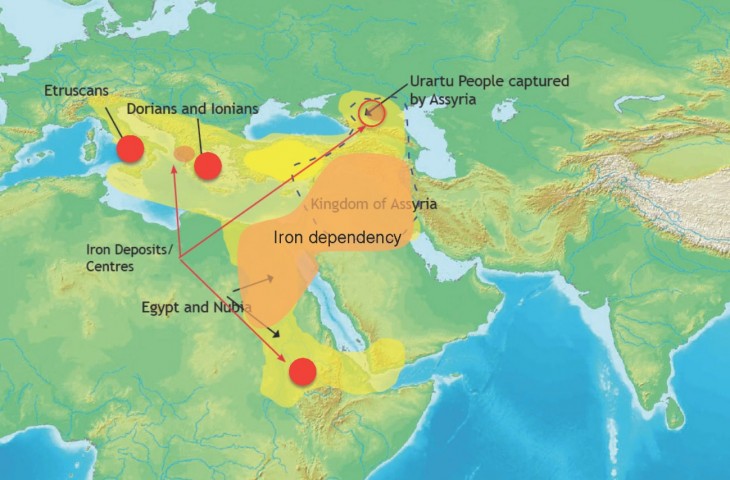In 1964 Bernard Rudofsky, a provocative architect and social commentator, published the book «Architecture without Architects», which is a continuation of his famous exhibition with the same name, presented architecture from all over the world, with the claim that architects should learn from premodern architectural forms. If we think about the connection between economy and architecture from this point of view, finding examples in ancient ages, when architects were working leading by their intuition and little knowledge about this world, to show dependences of these 2 spheres on a very basic level and therefore give a perspective of what we need to expect from actual state using the experience of previous times.
The Iron Age.
At first glance, in 800 BC, when iron firstly was found, territories were divided on 2 types: “the powers that be” (consider their geographical position, army conditions, sizes of their fortresses, legislation, art and etc.) and others, who were tribes with no civilization at all. But discovery of iron changed the world in a very dramatic way because it was an important global industrial commodity. Scientists can suggest that first people finding the iron, were Hitties, who lived in Anatolia (present day Turkey). It took a special skill and more developed technology but once it was developed, it seemed to have spread rapidly: better weapons, better plows, better building tools. So the iron had many advantages. Apart from being good for military, it was also good for making plows and instead of exporting and importing grain from far away, you could go to places that were very rocky and had bad soil conditions with a plow, turn the soil and improve its conditions. Therefore all of a sudden areas could become grain producing. The classic example of that is Sicily, which was a mountainous area, until the Greeks took their plows, brought them to the Sicily and turn it into one of the bread baskets of Europe. As a result, discovery of the iron has given an important asymmetry in the history of civilizations in the world.
So there were 4 areas that had iron and which approved in 800 BC, when no one ever really heard about them before. They are: Nubians (Sudan), Greece (Dorians), Italy (Etruscans) and Urartu (Armenia). These 4 areas became micro powers that 100 or 200 years would have been seen as the margins of the world. And they changed the whole civilizational dynamic.

The origin of the Etruscans is hotly debated. They settled predominantly in the north part of the Italian peninsula. This territory provided plenty of metal ore, such as copper, lead, silver and iron. It has not only the Etruscans’ economic acumen that differentiated them from the surroundings tribes but also their fantastic belief structure, which relied heavily on omens. Despite the settlements of the Greeks in the south and center Italy, the Etruscans were able to maintain their hold over the northern half of the Italian peninsula. There they had a vibrant interaction with Rome, the ascendant power, until they were finally absorbed into the Roman Empire as an up-and-coming people.
Because of using iron for tools they developed a masonry skills and it allowed them to create an amazing things, such as Velathri, Porta All’Arco and Porta di Diana. The city gate of Perugia in particular exhibited a bold use of arch, a building element that, along with the vault, was introduced by the Etruscans and became one of their main contribution to Roman architecture. In Rome itself, several famous structures, including the Circus Maximus and the Cloaca Maxima, were build by Etruscans masons the secure system of arches, that emerged in Etruria, had a tremendous impact on Roman architecture as is evidenced by the Roman aqueducts.
Nubians is another example. For a long time they had served as both slaves to the Egyptian pharaohs and as extension of his military. In 760 BC Nubians managed to take over the Egyptians because of iron production. 100 years after this Kingdom faltered, because they chopped down each and every tree that they could possibly see in the neighborhood. As a result, the territories of Sudan and Ethiopia produced much of desertification today.
What conclusion we can make from these 2 stories? Obviously, there can be seen close analogies with modern days. So during all the history we are continuously consuming, but use the output and regained time in different ways. Somebody success more, somebody – less. But, until we don’t find an alternative, the end of this path anyway is inevitable.
Humanity is mortal and it is a “near-perpetual” war for existence. We wish to become eternal and architecture is one of our success in this battle. All the Art is an attempt to understand ourselves, to express ourselves. We want to leave something, what we can call a reflection of time. It is a part of humanity’s nature but we need to spend resources on that. And this fact constitute the main connection between architecture and economic.
There are many ways that architecture can influence an economy and vice verse. This can be relate to macro and micro economics, to design of entire cities and individual buildings. Today people are worrying about how they interact with the city? How do they live? How do they transport? Can they combine activities to make city use more efficient? The thing is good architecture has to aware of those aspects which may have an economic impact on modern world and the history, which we won’t already see.
Good design Is a good business!

